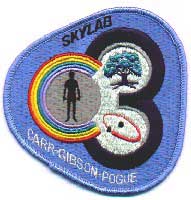

Crew & Mission
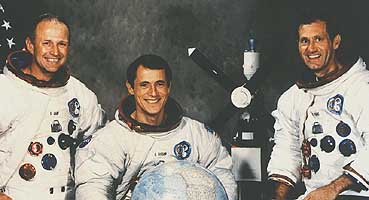 The Skylab 3 mission was initiated with the launch of three astronauts; Bill Pogue, Jerry Carr and Ed Gibson, in the Saturn IB rocket. Skylab 4 was launched on November 16, 1973.
The Skylab 3 mission was initiated with the launch of three astronauts; Bill Pogue, Jerry Carr and Ed Gibson, in the Saturn IB rocket. Skylab 4 was launched on November 16, 1973.
The main purpose of the third manned Skylab mission, was to extend the knowledge of human physiological adaptation to space flight and readaptation to Earth's gravity by continuing the comprehensive a medical research program begun on the first two Skylab missions. Since Skylab 4 lasted 84 days, it extended the astronauts' stay in space to almost three months.
Skylab 3 landed on February 8, 1974, making this mission a 84 days, 1 hour and 16 minutes in length, thus marking the longest mission in history for NASA.
A Personal story...
..."The three of us dreamed up the concept. Bill Pogue put together the description, and Barbara Matelski from the Johnson Spacecraft Center Graphics Department did the artwork. We gave our concept to several artist, but none of them came up with a design that delivered the message, so we rough sketched our idea, and Barbara put it together"...
Astronaut, Jerry Carr in "All we de was fly to the moon"
Artwork
"I did a design that incorporated an arabic "4" first probably in mid to late 1972 but I shelved it when Bill Schneider told us we were 1, 2, and 3. That's when a drew up one incorporating an arabic "3" When Dale Myers disapproved the design because of the official designation (2, 3, 4) I pulled out the original design and it was handed over to an artist to render a design to forward to headquasrters NASA. But the artwork was never finished. We were told that we could use the first ones submitted. I don't know where the one with the "4" in it is righ now but I ran across it a year or so ago so it is here in my house somewhere".
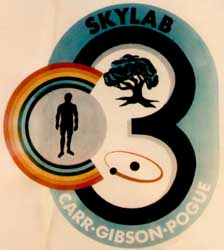
"I designed the preliminary emblem. With the major elements, rainbow circling the man, the tree and the hydrogen atom with the numeral "3" circling the tree and hydrogen atom. Jerry's wife, Joann, didn't like it so they turned it into the rounded "triangle." I have a polaroid color shot of the original design". (see above)
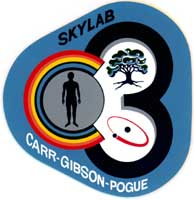
The symbology in the Skylab 3 patch refers to the three major areas of investigation proposed in the mission and the spirit of unification which the crew feels is an essential element in man's natural environment and relates directly to the Skylab mission objective of advanceing the study of earth resources.
The hydrogen atom, as the basic building block of the universe, represents man's exploration of the phsical world, his application of knowledge, and his development of technology. Since the sun is composed primarily of hydrogen, it is appropriate that the symbol also refers to the the Solar Physics mission objectives.
The human silhouette represents mankind and the human capacity to direct technology with a wisdom tempered by regard for his natural enviroment. It also directly relates to the Skylab medical studies of man himself. The rainbow, adopted from the Biblical story of the Flood, symbolizes the promise that is offered to man. It embraces man and extends to the tree and hydrogen atom, emphasizing man's pivotal role in the conciliation of technology with nature by humanistic application of our scientific knowledge.
Thank's to Astronaut William R. Pogue, March - April 2003.
Lion Brothers
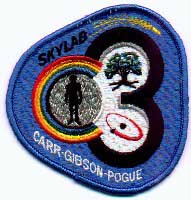
This is the Lion Brothers version of the Skylab-3 crewpatch, it features the comet Kohoutek in the top of the patch and also the initials of the 3 astronauts.
"AB Emblem made our patch. I know because I visited their factory in the late seventies or early eighties and they were still complaining about the rainbow in our emblem. We (crew) were all given a set of 100 of the comet emblems (limited edition). I never knew who did them. I didn't know about it untill they arrived by mail."
Astronaut William R. Pogue, March - April 2003.
One of the main objectives of the Skylab-3 mission was to observe the comet Kohoutek, wich had been discovered in March 1973, and only orbited near the earth and the sun every 80,000 years. It was thought at the time that this would be the biggest astronomical event since Halley's comet had last arrived in 1910. Unfortunately, Kohoutek did not live up to its promise as a major astronomical event, although the crew was able to collect much data.
From: "Space Patches, from Mercury to the Space Shuttle"
Something Different
This strange metallic card was used at the Kennedy Space Center during launch processing. As you can see the colors are wrong but the card was used on hardware to identify it for a specific mission. I suppose this is the reason for the distinctive colors. You will note that there is a "peel-off" cover on the back to expose an adhesive surface for easy application on hardware.
Astronaut William R. Pogue, June 2003.